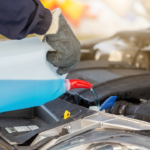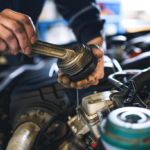Table of Contents
The Importance of Summer Car Maintenance Habits
Summer is here, and it’s time for road trips, beach days, and plenty of fun in the sun. But before you hit the open road, it’s important to make sure your car is ready for the heat.
Regular maintenance can help keep your car running smoothly and prevent costly repairs down the line. Here are some essential summer car maintenance habits to keep in mind.
Maximizing the Lifespan of Your Car
Your car is a big investment, so it makes sense that you want it to last as long as possible. Proper maintenance can help extend your car’s lifespan and save you money in the long run.
If you take care of your car now, it will take care of you later. By keeping up with regular maintenance tasks and addressing issues as they arise, you can ensure that your vehicle stays reliable for years to come.
There are a few key areas to focus on when it comes to summer car maintenance habits: keeping your car cool, checking your tires, regularly changing oil and filters, protecting your car’s exterior, and monitoring battery health. We’ll go into detail about each of these areas in the following sections so that you can get started on ensuring that your vehicle is ready for all of your summertime adventures.
Keep Your Car Cool
Check and Maintain Proper Coolant Levels
One of the most important things you can do to keep your car cool during the summer is to regularly check and maintain proper coolant levels. Coolant, which is also known as antifreeze, is a liquid that absorbs heat from your engine and helps dissipate it through the radiator.
If your coolant levels are low, your engine will overheat, which can cause serious damage. Check your owner’s manual for instructions on how to check and add coolant if necessary.
Inspect and Replace Damaged or Worn Out Hoses
Another way to keep your car cool during the summer is to inspect and replace any damaged or worn-out hoses. Hoses are an important part of your car’s cooling system because they carry coolant from the engine to the radiator. If a hose ruptures or becomes brittle, it can cause a leak in the cooling system, which can lead to overheating.
Inspect hoses for cracks, leaks, or signs of wear regularly. It’s recommended that you replace all hoses every four years regardless of their condition.
Regularly Clean the Radiator to Prevent Clogs
It’s important to regularly clean the radiator to prevent clogs. Over time, dirt and debris can accumulate on the outside of the radiator fins, which can reduce its ability to dissipate heat efficiently. Use a soft-bristled brush or compressed air to remove any debris from between the fins.
You should also periodically flush out your cooling system with water or a specialized flushing solution designed for this purpose – consult with a mechanic if you’re not sure what type of flushing solution would be appropriate for your vehicle. By following these simple tips for keeping your car cool during hot summer weather – checking coolant levels regularly; inspecting and replacing any damaged or worn-out hoses; and cleaning the radiator to prevent clogs – you can help ensure that your vehicle stays running smoothly and avoid costly repairs down the road.
Check Your Tires
One of the most important maintenance habits to adopt for your car during summer is checking your tires regularly. Tires are the only contact point between the car and the road and can greatly impact the safety, fuel efficiency, and handling of your car.
To ensure optimal tire performance, it’s essential to check tire pressure at least once a month. Under-inflated tires can lead to increased wear and tear, poor gas mileage, and even blowouts.
Over-inflating tires can also be dangerous as they reduce traction on the road. Use a tire pressure gauge to check inflation levels and make sure they’re in line with what’s recommended by your car manufacturer.
In addition to checking pressure levels, inspecting tire tread depth is also crucial. The minimum tread depth required for safe driving is 2/32 inch, but experts recommend a minimum of 4/32 inch for better traction on wet surfaces.
You can easily measure tread depth using a penny or a specialized tool called a tread depth gauge. If you notice that the treads are worn out or unevenly worn out, it’s time to replace them.
Rotate Tires Every 5,000 Miles
Rotating your tires every 5,000 miles is another important habit that helps ensure even wear and tear on all four wheels of your car by moving them from one position to another. This way, your tires will last longer since they’ll be exposed uniformly rather than having certain parts subject to more stress than others. Depending on whether you have front-wheel drive or rear-wheel drive vehicles or all-wheel drive systems which distribute power across all four wheels equally- each tire wears differently over time with different stressors exerted upon them depending how you operate your vehicle.. Rotating them ensures that any differences in wear between front and back are equalized over time so that none of them become excessively worn down.
Replace Worn Out Tires Before They Become a Safety Hazard
If you notice that your tires are worn out, don’t hesitate to have them replaced. Driving on bald or excessively worn tires is not only dangerous but illegal in some states as well.
While you may be tempted to delay replacement to save money, doing so increases the risk of tire blowouts, accidents and reduced handling performance. Alternatively, check out the tread wear bar indicators built into your tires.
These are small rubber bars woven into the tire’s grooves that indicate when it’s time to replace them.. When tread wear bars become visible inside grooves of tire treads- it means tread depth is likely 2/32 inch or less and you need new ones for sure! By regularly checking and maintaining proper tire pressure levels, rotating your tires every 5,000 miles and replacing worn out ones when necessary- You can prolong their lifespan and enjoy a smoother ride while keeping your car safe at all times!
Regularly Change Oil and Filters
Changing the oil and filters in your car is one of the most important things you can do to extend its lifespan. Oil lubricates the internal working parts of your engine, reducing friction and preventing damage. Over time, the oil breaks down and loses its effectiveness, which is why it needs to be changed regularly.
How often you need to change your oil depends on several factors, including the make and model of your car, how often you drive it, and the type of driving conditions you encounter. Most manufacturers recommend changing your oil every 3,000 to 5,000 miles.
However, if you frequently drive in stop-and-go traffic or extreme temperatures or if you haul heavy loads with your car regularly, you may need to change it more frequently. Check your owner’s manual for recommendations specific to your vehicle.
Change Air Filters Every 12K Miles or As Needed
Another important part of regular car maintenance is replacing air filters. Air filters help prevent dirt, dust, and other contaminants from entering your engine’s combustion chamber. Over time, these filters can become clogged with debris, which can reduce engine performance and fuel efficiency.
Most manufacturers recommend changing air filters every 12 months or every 12,000 miles – whichever comes first. However, if you drive in dusty or dirty conditions frequently (such as on gravel roads), then it may be necessary to replace them more often.
You can also visually inspect air filters by holding them up to a light; if they appear dark or dirty at all the filter should be replaced immediately. To ensure that you are doing everything possible to extend the life of your vehicle – keep up with regular scheduled maintenance including these two important items – changing air Filters consistently as well as regularly changing out the oil.
Protect Your Car’s Exterior
Wash and Wax Regularly to Protect Against UV Rays and Other Environmental Factors
Keeping your car clean is not just for aesthetic purposes, it can also protect your car’s exterior from harsh environmental factors like UV rays, bird droppings, and tree sap. Regular washing will help remove harmful substances that can corrode or damage the paint over time. You should aim to wash your car at least once a week during summer months, especially if you live in an area with high humidity or near a beach.
Waxing is another important step in protecting your car’s exterior. Applying a layer of wax creates a barrier between the paint and the sun’s rays, preventing fading or peeling.
It also helps repel water and other volatile compounds that can leave stains on the surface of the car. Be sure to use a high-quality wax product that is specifically designed for cars.
Use a High-Quality Car Cover When Parked for Extended Periods in Direct Sunlight
If you are planning on parking your car for an extended period of time in direct sunlight, consider using a high-quality car cover to protect it from prolonged exposure to UV rays. A good cover will not only protect against sun damage but also prevent scratches from debris or dust blowing around in windy conditions. When selecting a cover, make sure it fits snugly on your vehicle without sagging or flapping around in the wind.
It should be made from breathable materials that allow air circulation while still providing adequate protection for your car’s exterior. A well-chosen cover can extend the life of your paint job by several years while helping keep dust and debris out of any crevices where they might build up over time.
Taking steps to protect your vehicle’s exterior may seem tedious, but these habits are essential if you want to maximize its lifespan. By washing and waxing regularly and using a high-quality cover, you can keep your car looking new for years to come.
Monitor Battery Health
Your car’s battery is the life force of your vehicle. Without it, you won’t be able to start your engine or use any of the electronics in your car.
That’s why it’s important to keep an eye on your battery health, especially during hot summer months when batteries are more prone to failure. To check your battery health, you can use a multimeter or take your car to a mechanic who can test it for you.
You should also keep an eye out for any signs that may indicate a weak battery such as slow engine cranking, dimming headlights, or warning lights on the dashboard. If you notice any of these symptoms, it may be time to replace your battery.
Check Battery Health Regularly
It’s crucial to check your battery health regularly if you want to prolong its lifespan and avoid any unexpected breakdowns. Experts recommend checking once a month or at least every three months. This way, you can catch any issues before they become major problems and potentially save yourself from costly repairs down the road.
One way to keep track of when you last checked your battery is by marking the date on a calendar or setting reminders on your phone so that you don’t forget. Remember that prevention is always better than cure!
Clean Battery Terminals
Battery terminals can develop corrosion over time due to exposure to heat and moisture which can cause electrical resistance and lead to starting problems in older cars that do not have fully integrated electrical systems with multiple batteries distributing loads across them. To clean corrosion off terminals or connectors use baking soda mixed with water and apply with an acid brush available at most auto stores then rinse off with water after 5 minutes let dry then apply dielectric grease available at auto stores as well this will protect against future corrosion for years.When cleaning never touch both negative (black) terminal first, allowing the brush to touch anything other than the negative terminal may cause a spark that can lead to an explosion of gases that can build up around the battery.
Conclusion
Taking care of your car during the summer months can make a huge difference in extending its lifespan. By following these proper maintenance habits, you can ensure that your car stays in great shape and lasts for many years to come.
Not only will proper summer maintenance help you save money on costly repairs in the long run, but it will also keep your car running smoothly and safely. Regular check-ups, including monitoring coolant levels, inspecting tires, changing oil and filters, protecting your car’s exterior, and monitoring battery health can all prevent major issues from occurring down the road.
If you want to make the most out of your investment in a vehicle, then taking these simple steps to maintain it during the summer months is essential. Remember that by maintaining good habits today, you’ll be able to enjoy a more reliable ride tomorrow!






